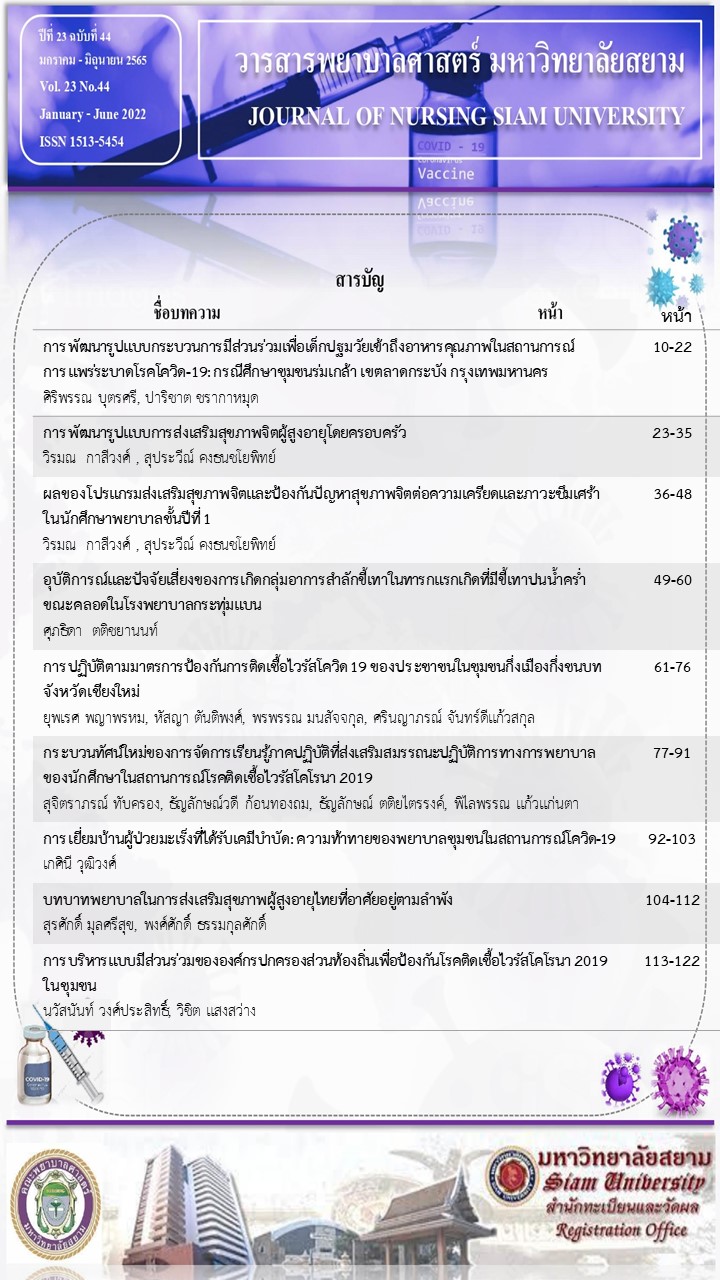The ผลของโปรแกรมส่งเสริมสุขภาพจิตและป้องกันปัญหาสุขภาพจิตต่อความเครียดและภาวะซึมเศร้า ในนักศึกษาพยาบาลชั้นปีที่ 1
คำสำคัญ:
การส่งเสริมสุขภาพจิต, การป้องกันปัญหาสุขภาพจิต, ความเครียด, ภาวะซึมเศร้า, นักศึกษาพยาบาลบทคัดย่อ
วัตถุประสงค์ เพื่อศึกษา 1) ข้อมูลพื้นฐานภาวะสุขภาพจิตนักศึกษาพยาบาลชั้นปีที่ 1 2) โปรแกรมการส่งเสริมสุขภาพจิตและป้องกันปัญหาสุขภาพจิตนักศึกษาพยาบาลชั้นปีที่ 1 3) เปรียบเทียบความเครียดและภาวะซึมเศร้า ก่อนและหลังเข้าร่วมโปรแกรมการส่งเสริมสุขภาพจิตและป้องกันปัญหาสุขภาพจิตนักศึกษาพยาบาลชั้นปีที่ 1
รูปแบบและวิธีดำเนินการวิจัย การวิจัยกึ่งทดลอง (Quasi-experimental research) แบบ One Group Pretest – Posttest Design ดำเนินการ 2 ระยะ คือ ระยะที่ 1 ศึกษาข้อมูลพื้นฐานภาวะสุขภาพจิต และพัฒนาโปรแกรมการส่งเสริมสุขภาพจิตและป้องกันปัญหาสุขภาพจิตนักศึกษาพยาบาลชั้นปีที่ 1 ระยะที่ 2 ทดลองใช้โปรแกรม ดำเนินการระหว่าง เดือน สิงหาคม - ธันวาคม 2564
ผลการวิจัย ระยะที่ 1 ภาวะสุขภาพจิตนักศึกษาพยาบาลชั้นปีที่ 1 จำนวน 175 คน โดยใช้แบบประเมินความเครียดสวนปรุง พบว่ามีความเครียดระดับสูง ร้อยละ 31.43 ความเครียดระดับรุนแรง ร้อยละ 20.0 และใช้แบบวัดอาการซึมเศร้า CES-D (Center for Epidemiologic Studies-Depression Scale) พบว่าเสี่ยงต่อภาวะซึมเศร้า ร้อยละ 14.29 โปรแกรมการส่งเสริมสุขภาพจิตและป้องกันปัญหาสุขภาพจิตในนักศึกษาพยาบาลชั้นปีที่ 1 มี 3 ขั้นตอน คือขั้นตอนที่ 1 การสำรวจและการคัดกรองปัญหาทางจิต ขั้นตอนที่ 2 การจัดกิจกรรมส่งเสริมสุขภาพจิตและป้องกันปัญหาสุขภาพจิต ขั้นตอนที่ 3 ประเมินผลการดำเนินงาน ผลการวิจัยระยะที่ 2 การทดลองใช้โปรแกรมการส่งเสริมสุขภาพจิตและป้องกันปัญหาสุขภาพจิต กลุ่มตัวอย่าง คือนักศึกษาพยาบาลชั้นปีที่ 1 ที่มีความเสี่ยงปัญหาสุขภาพจิต จำนวน 23 คน วิเคราะห์ความแตกต่างระหว่างระดับความเครียดและภาวะซึมเศร้าก่อนและหลังเข้าร่วมกิจกรรม ด้วยสถิติ Paired t -test พบว่าแตกต่างกันอย่างมีนัยสำคัญทางสถิติ (p ˂ 0.05) โดยความเครียดก่อนเข้าร่วมกิจกรรมมีค่าเฉลี่ย 66.48 หลังเข้าร่วมกิจกรรมมีค่าเฉลี่ย 38.21 ภาวะซึมเศร้าก่อนเข้าร่วมกิจกรรมมีค่าเฉลี่ย 23.04 หลังเข้าร่วมกิจกรรมมีค่าเฉลี่ย 9.52
สรุปและข้อเสนอแนะ ควรดูแลสุขภาพจิตนักศึกษาพยาบาลชั้นปีที่ 1 โดยการคัดกรองปัญหาสุขภาพจิต การจัดกิจกรรมส่งเสริมสุขภาพจิตและป้องกันปัญหาสุขภาพจิต และการติดตามประเมินผลอย่างต่อเนื่อง
เอกสารอ้างอิง
กชกร ฉายากุ.(2561). ผลของโปรแกรมเสริมสร้างพลังสุขภาพจิตในนักศึกษาพยาบาลวิทยาลัย พยาบาลบรมราชชนนีนครราชสีมา. วารสารวิทยาลัยพยาบาลบรมราชชนนี นครราชสีมา, 24(2), 96-124.
ฉันทนา แรงสิงห์ และ สถิตย์ วงศ์สุรประกิต. (2557). ปัจจัยทางสุขภาพจิตที่มีผลต่อพฤติกรรมการเรียนของนักศึกษาชั้นปีที่ 1 มหาวิทยาลัยแม่ฟ้าหลวง. วารสารพยาบาลสาร, 41(1), 122-132.
เนาวรัตน์ สิงห์สนั่น และจุฬาลักษณ์ นิลอาธิ. (2563). การนำ SATIR MODEL สู่การปฏิบัติในการดูแล สุขภาพจิตของนักศึกษาพยาบาล. วารสารมหาจุฬานาครทรรศน์, 7 (9), 17-29.
ลักษณา สกุลทอง, ภมรพรรณ์ ยุระยาตร์ และสุทธิพงศ์ หกสุวรรณ.(2561). การพัฒนาโมเดลการฝึกอบรมเพื่อพัฒนาความผาสุกทางจิตใจของนิสิตนักศึกษาในมหาวิทยาลัย. วารสาราชพฤกษ์, 16 (1),76-87.
วารีรัตน์ ถาน้อย อทิตยา พรชัยเกตุ ภาศิษฎา อ่อนดี. (2555). ปัจจัยที่มีอิทธิพลต่อภาวะสุขภาพจิต ของนักศึกษาคณะพยาบาลศาสตร์ มหาวิทยาลัยมหิดล. วารสารสภาการพยาบาล, 27 (ฉบับพิเศษ), 60-76.
วิรมณ กาสีวงศ์. (2562). รายงานการสำรวจภาวะสุขภาพจิตนักศึกษาพยาบาล. มหาวิทยาลัยนครพนม: ฝ่ายวิชาการ.
สมจิตร์ นคราพานิช และ รัตนา พึ่งเสมา.(2564). ปัจจัยทำนายพลังสุขภาพจิตของนักศึกษาพยาบาลชั้นปีที่ 1. วารสารวิทยาลัยพยาบาลสภากาชาดไทย, 35 (1), 128-145.
สุวัฒน์ มหัตนิรันดร์กุล, วนิดา พุ่มไพศาลชัย และ พิมพ์มาศ ตาปัญญา.(2540). การสร้างแบบวัดความเครียด สวนปรุง. วารสารสวนปรุง, 13(3), 1-20 .
สายใจ พัวพันธ์, จิณห์จุฑา ชัยเสนา ดาลลาส และดวงใจ วัฒนสินธ์.(2558). ปัจจัยที่มีอิทธิพลต่อภาวะสุขภาพจิตของนักศึกษาพยาบาล.วารสารคณะพยาบาลศาสตร์มหาวิทยาลัยบูรพา, 23(3), 1-13.
สภาการพยาบาล.(2564). มาตรฐานคุณวุฒิระดับปริญญาตรี สาขาพยาบาลศาสตร์ พ.ศ. 2560 .สืบค้น วันที่ 1 มกราคม 2564 เข้าถึงได้จาก https://www.tnmc.or.th/news/18.
อุมาพร ตรังคสมบัติ, วชิระ ลาภบุญทรัพย์ และปิยลัมพร หะวานนท์. (2540). การใช้ CES-D ในการคัด กรองภาวะซึมเศร้าในวัยรุ่น. วารสารสมาคมจิตแพทย์แห่งประเทศไทย, 42(1), 2-13 Chen, C.-J., et al. (2015). The prevalence and related factors of depressive symptoms among junior college nursing students: Retrived 9th,November, 2021 from https://doi.org/10.1111/jpm.12252.
Herrman, H & Jané-Llopis, E. (2014).The Status of Mental Health Promotion. Public health review, 34 (2),1-20.
Johansso, E. (2010). Effectiveness of a Stress Management Program in Reducing Anxiety and Depression in Nursing Students. Journal of American College Health, 40 (3),125-129.
Rathnayake, S. & Ekanayaka , J. (2016). Depression, Anxiety and Stress among undergraduate Nursing Students in a Public University in Sri Lanka. International Journal of Caring Sciences ,9 (2016), 1020 -1032.
ดาวน์โหลด
เผยแพร่แล้ว
รูปแบบการอ้างอิง
ฉบับ
ประเภทบทความ
สัญญาอนุญาต
ลิขสิทธิ์ (c) 2022 วารสารพยาบาลศาสตร์ มหาวิทยาลัยสยาม

อนุญาตภายใต้เงื่อนไข Creative Commons Attribution-NonCommercial-NoDerivatives 4.0 International License.
เนื้อหาและข้อมูลที่เผยแพร่ในวารสารพยาบาลศาสตร์ มหาวิทยาลัยสยามถือเป็นข้อคิดเห็นและความรับผิดชอบของผู้นิพนธ์บทความโดยตรง
บทความ เนื้อหา ข้อมูล รูปภาพ ฯลฯ ที่ได้รับการเผยแพร่ในวารสารพยาบาลศาสตร์ มหาวิทยาลัยสยาม ถือเป็นลิขสิทธิ์ของวารสารพยาบาลศาสตร์ มหาวิทยาลัยสยาม หากบุคคลหรือหน่วยงานใดต้องการนำทั้งหมดหรือส่วนหนึ่งส่วนใดไปเผยแพร่หรือเพื่อกระทำการใด ๆ จะต้องอ้างอิงวารสารพยาบาลศาสตร์ มหาวิทยาลัยสยามทุกครั้ง



